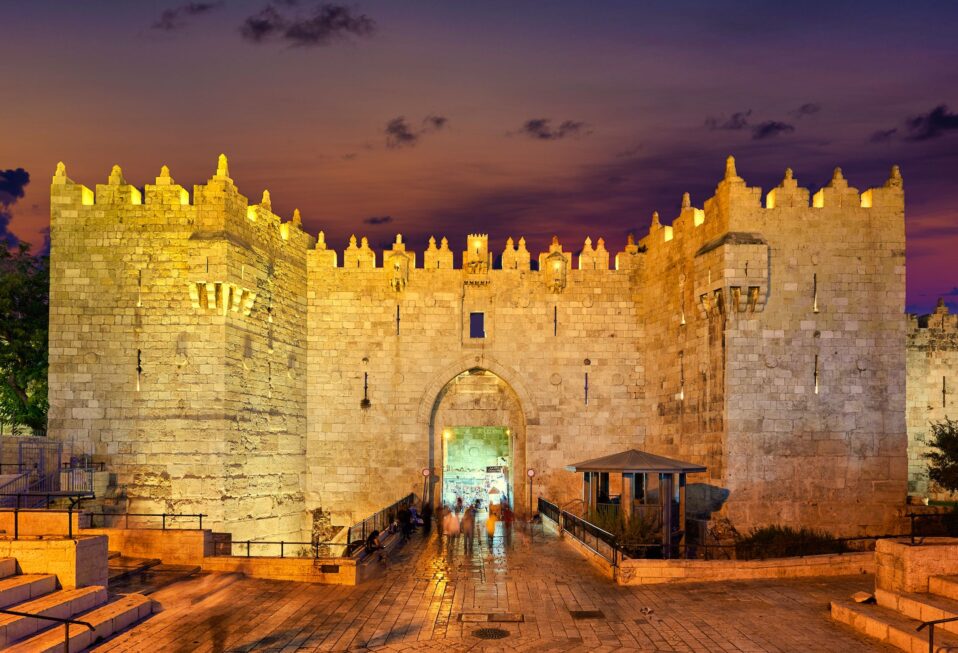By Marc Turnage
Visitors to the Old City of Jerusalem today can enter the city through seven gates scattered around its eastern, southern, western, and northern sides. These gates, like the walls of the Old City, date to the Ottoman Period (16th-20th centuries).
Along the northern stretch of the Old City walls are three gates, from west to east, New Gate, Damascus Gate, and the Flower (or Herod’s) Gate. The current Ottoman Damascus Gate stands upon the remains of a triple-arch gate that dates to the Roman remains of Aelia Capitolina, which was the name given to Jerusalem in the 2nd century A.D. by the Roman Emperor Hadrian. The center arch was the largest, and the two side arches were lower.
Gates are named for what lies outside of them; therefore, Damascus Gate gains its name because the northern road towards Damascus leads out of the city from there. In Hebrew, the gate is referred to as Shechem Gate because the road to Shechem (modern day Nabulus) led out of the city from there.
After the destruction of Jerusalem by the Romans in A.D. 70, the city’s footprint changed due to the damage caused by the Roman forces in certain parts of the city, particularly the southern area of the city. This caused the city to shift north and west in the Late Roman Period. From the 2nd century A.D., Jerusalem began to look like a Roman city, which the Old City of Jerusalem more or less parallels until today.
The Roman Emperor Hadrian renamed Jerusalem, Aelia Captitolina, and the province Judaea, he changed its name to Palestina. As part of the rebuilding of Jerusalem (Aelia Capitolina), the triple-arch, on which Damascus Gate now stands, was constructed.
This triple-arch gate marked the northern limit of the city. The triple-arch gate was originally free standing, but in the late 3rd century, it was connected to the city’s wall. Entering through the arches, one encountered a paved plaza (similar to what one does entering through today’s Damascus Gate) in which Jerusalem’s two main north-south roadways came together. It seems that a column stood in this plaza, probably with a statue of the emperor on it.
A mosaic map of the Holy Land in the floor of a church in Maedaba, Jordan that dates to the 6th century A.D. depicts the column, without the statue, standing in the plaza in front of the Damascus Gate. Until today in Arabic, one refers to Damascus Gate as Bab al-‘Amud, the Gate of the Column, which retains the memory of the column in the plaza.
The triple-arches of the Later Roman Period were built on a stretch of wall that dates back to the first century.
Marc Turnage is President/CEO of Biblical Expeditions. He is an authority on ancient Judaism and Christian origins. He has published widely for both academic and popular audiences. His most recent book, Windows into the Bible, was named by Outreach Magazine as one of its top 100 Christian living resources. Marc is a widely sought-after speaker and a gifted teacher. He has been guiding groups to the lands of the Bible—Israel, Jordan, Egypt, Turkey, Greece, and Italy—for over twenty years.
Website: WITBUniversity.com
Facebook: @witbuniversity
Podcast: Windows into the Bible Podcast




Comment(1)-





Sue Stone says
July 30, 2022 at 4:41 pmWhich gate did Moshe Dayan lead the Israeli forces through to the Kotel after the 1967 victory? Lion’s Gate? Where is it in relation to Damascus gate? Thank you for this article. I love learning about old Jerusalem while looking forward to New Jerusalem—always the center of GOD’s Universe.
Receive Devotionals and News Updates from Israel
Recent Posts
Parashat Vayishlach (וַיִּשְׁלַח) “He Sent”
The World’s Most Enduring Best Seller is Timelier Than Ever
Nourishing Israel’s Forgotten Seniors
Nazareth: The Village That Formed the Messiah